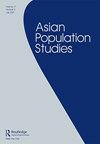Momentum of Chinese migration scholarship in East and Southeast Asia
IF 1.5
4区 社会学
Q2 DEMOGRAPHY
引用次数: 2
Abstract
Chinese people have had a presence in East and Southeast Asia for centuries. According to the United Nations (UN) classification, East and Southeast Asia include diverse economies. Our discussion follows the UN definition and focuses on these economies. In 2020, over 30 million Chinese lived in Southeast Asia in countries such as Indonesia, Malaysia, Myanmar, Philippines, Singapore, Thailand, and Vietnam (Lockard, 2013; Wong, 2013; Zhuang & Wang, 2010). With the implementation of China’s Belt and Road Initiative launched in 2013, there has been rapid economic integration between China and the Association of Southeast Asian Nations (ASEAN), which has resulted in a large volume of Chinese labour migration within the area (Fong & Shibuya, 2020; Van Chinh, 2013; Wong, 2013). According to UN data on the international migrant stock by destination and origin, the number of Chinese immigrants in East and Southeast Asia increased dramatically between 1990 and 2019, from about 825,000 to 2,084,000. In some countries, such as Cambodia, Japan, Korea, Thailand, and Vietnam, the mainland Chinese migrant population grew more than 100 per cent. It is clear that there has been a visible increase in the number of migrants from mainland China in the region. Despite the large number of migrants from mainland China, large-scale comparative studies of this migration flow have been surprisingly sparse. Using the same UN data set, Abel et al. (2019) and Fong et al. (2020) have explored general patterns of Asian migration. Yet, they did not focus on migration patterns from mainland China specifically. Studies based on individual-level survey data investigating the motivations and destination choices of Chinese migrants in the region are almost absent. The increase in migration of Chinese individuals to Southeast Asia inevitably has also led to the discussion about their economic and social integration. The economic integration of Chinese labour migrants to Southeast Asia is associated with the increasing bilateral trade of China with other countries in the region. The total trade between China and ASEAN rose from US$7 billion in 1990 to US$202 billion in 2007 (Zhuang & Wang, 2010). By 2013, China was the largest foreign investor in Myanmar, Lao PDR, and Cambodia. They found that Chinese products occupied a great part of the Southeast Asia market that helped the economic integration of local Chinese immigrant businessmen (Zhuang & Wang, 2010). However, the current literature on growing economic presence in various economies in East and Southeast Asia, and specifically the relationship东亚和东南亚华人移民学术的发展势头
几个世纪以来,中国人一直在东亚和东南亚存在。根据联合国(UN)的分类,东亚和东南亚包括不同的经济体。我们的讨论遵循联合国的定义,重点关注这些经济体。2020年,超过3000万中国人居住在东南亚国家,如印度尼西亚、马来西亚、缅甸、菲律宾、新加坡、泰国和越南(Lockard, 2013;黄,2013;庄和王,2010)。随着2013年中国“一带一路”倡议的实施,中国与东南亚国家联盟(东盟)之间的经济一体化迅速发展,这导致了该地区大量的中国劳动力迁移(Fong & Shibuya, 2020;Van Chinh, 2013;黄,2013)。根据联合国按目的地和来源国分列的国际移民存量数据,1990年至2019年,东亚和东南亚的中国移民数量大幅增加,从约82.5万人增加到208.4万人。在一些国家,如柬埔寨、日本、韩国、泰国和越南,中国大陆移民人口增长了100%以上。很明显,该地区来自中国大陆的移民人数明显增加。尽管有大量来自中国大陆的移民,但对这一移民流动的大规模比较研究却出奇地少。Abel等人(2019)和Fong等人(2020)使用相同的联合国数据集探索了亚洲移民的一般模式。然而,他们并没有特别关注来自中国大陆的移民模式。基于个人层面调查数据调查中国移民在该地区的动机和目的地选择的研究几乎缺失。越来越多的中国人移民到东南亚,不可避免地引发了关于他们经济和社会融合的讨论。中国劳工移民到东南亚的经济一体化与中国与该地区其他国家日益增长的双边贸易有关。中国与东盟的贸易总额从1990年的70亿美元增长到2007年的2020亿美元(Zhuang & Wang, 2010)。截至2013年,中国已成为缅甸、老挝和柬埔寨的最大外国投资者。他们发现中国产品占据了东南亚市场的很大一部分,这有助于当地中国移民商人的经济融合(Zhuang & Wang, 2010)。然而,目前关于东亚和东南亚各经济体日益增长的经济存在的文献,特别是它们之间的关系
本文章由计算机程序翻译,如有差异,请以英文原文为准。
求助全文
约1分钟内获得全文
求助全文
来源期刊

Asian Population Studies
DEMOGRAPHY-
CiteScore
3.30
自引率
14.30%
发文量
12
期刊介绍:
The first international population journal to focus exclusively on population issues in Asia, Asian Population Studies publishes original research on matters related to population in this large, complex and rapidly changing region, and welcomes substantive empirical analyses, theoretical works, applied research, and contributions to methodology.
 求助内容:
求助内容: 应助结果提醒方式:
应助结果提醒方式:


